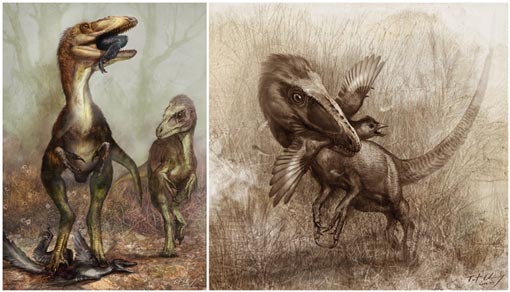Dinosaur Stomach Contents – Small Theropod Ate Birds According to New Research
Sinocalliopteryx – Stealthy Hunter or Fortunate Scavenger
Research by a joint Canadian/Chinese team of scientists has shed light on the dietary habits of a small theropod dinosaur that roamed the forests of what was to become the Liaoning Province of China back in the Early Cretaceous. Analysis of the stomach-acid etched bones found in the abdominal cavity of two specimens of the large compsognathid predator Sinocalliopteryx gigas shows that these ground-dwelling predators ate a variety of prey including primitive birds.
Small Theropod Dinosaur
The fossilised remains of two Early Cretaceous birds has led some scientists to speculate that this cursorial, big-eyed hunter used stealth and guile to enable it to stalk and catch flying creatures. Other palaeontologists don’t quite go so far, stating that the stomach contents show that these 2.5-metre-long dinosaurs did indeed eat birds but how they caught them cannot be determined from the fossil evidence.
Two Fossils of Sinocalliopteryx
The two fossils of Sinocalliopteryx were both excavated from the Jianshangou Beds of the lower Yixian Formation, Liaoning, China. The fossils are approximately 135 million years old and date from a time when lush, tropical forest covered the area. There were active volcanoes nearby and several large lakes. The holotype fossil material of S. gigas preserves a partial dromaeosaurid leg in the abdominal cavity. This indicates that dinosaurs were also on the menu for these hunters. The unfortunate victim may have been a Sinornithosaurus, a feathered dinosaur that may have reached lengths in excess of a metre. It looks like one predatory dinosaur was eaten by a bigger predator.
Sinocalliopteryx gigas
A second, newly-discovered specimen preserves the remains of at least two individuals of the primitive avian, Confuciusornis sanctus, in addition to acid-etched bones including a scapula (shoulder blade) from a possible Ornithischian dinosaur which has yet to be described. The presence of two bird skeletons inside the stomach has led some scientists to propose that Sinocalliopteryx was an active hunter, able to catch birds, perhaps by leaping up and plucking them out of the air.
For figures and replicas of theropods and other dinosaurs: Dinosaur Models and Figures (CollectA Figures).
A dinosaur preying on birds is not a new concept. The great Charles R. Knight, in an illustration of the small theropod Ornitholestes (Late Jurassic of the Western United States) depicted a dinosaur attempting to catch birds. However, since no avian fossil material has been found in the same strata as Ornitholestes fossil material, this predator/prey relationship could only be speculated, now thanks to these Chinese fossils there is certainly evidence to suggest that dinosaurs did eat birds.
To read more about the Charles Knight illustration of Ornitholestes: Ornitholestes – Bird Stealer.
Although it cannot be stated whether such prey items were scavenged or actively hunted, the presence of the remains of two Confuciusornis in a similar state of digestion suggests they were consumed in rapid succession. This makes the idea of scavenging two carcases of the same species in quick succession less likely, although a group of birds dying together is not unheard of. Perhaps a methane gas escape from a nearby lake suffocated a lot of small animals and birds as they roosted.
The dead creatures would have fallen out of the trees and provided the ground dwelling Sinocalliopteryx with a feast. Given the lack of clear arboreal adaptations in Sinocalliopteryx, indeed, given the adaptations this small dinosaur had for a cursorial life-style, some of the scientists who have written the research paper have suggested that this dinosaur may have hunted birds in a similar way to a modern domestic cat. It does not seem well suited to climbing trees, but may have been one of the top ground-dwelling predators in the lush forests of Liaoning Province.
An Illustration of the Agile Hunter – Sinocalliopteryx gigas
Picture credit: Cheung Chungtat


